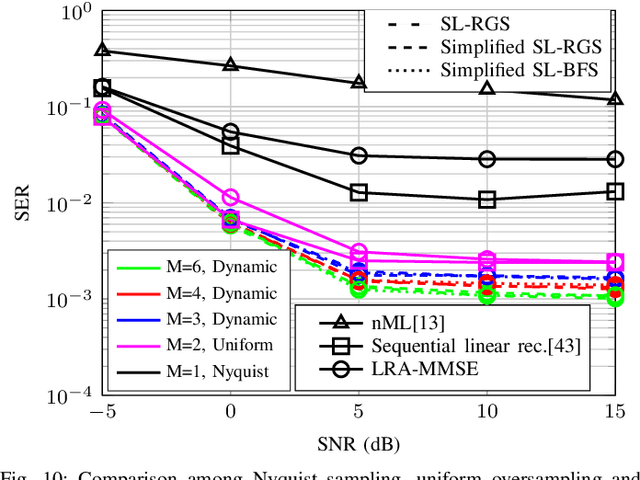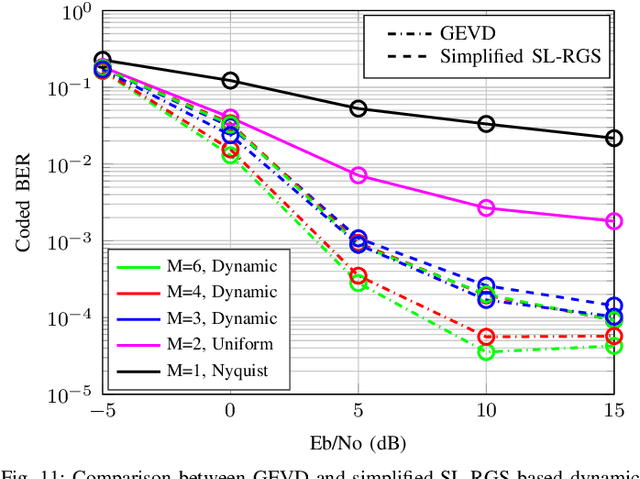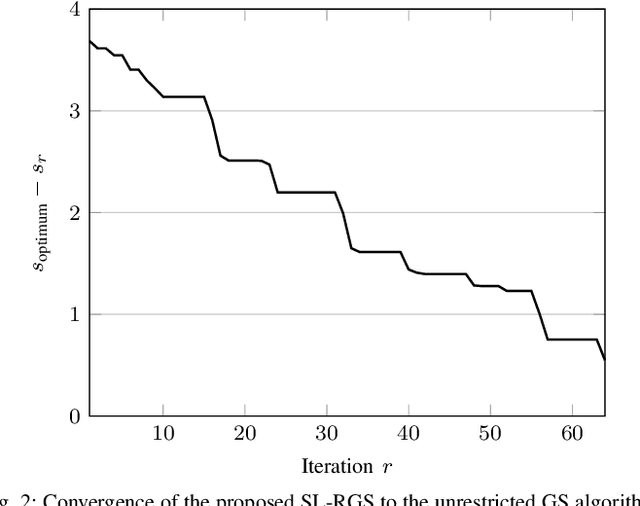R. de Lamare
Efficient Robust Adaptive Beamforming Based on Spatial Sampling with Virtual Sensors
Mar 09, 2025Abstract:Robust adaptive beamforming (RAB) based on interference-plus-noise covariance (IPNC) matrix reconstruction can experience serious performance degradation in the presence of look direction and array geometry mismatches, particularly when the input signal-to-noise ratio (SNR) is large. In this work, we present a RAB technique to address covariance matrix reconstruction problems. The proposed method involves IPNC matrix reconstruction using a low-complexity spatial sampling process (LCSSP) and employs a virtual received array vector. In particular, we devise a power spectrum sampling strategy based on a projection matrix computed in a higher dimension. A key feature of the proposed LCSSP technique is to avoid reconstruction of the IPNC matrix by integrating over the angular sector of the interference-plus-noise region. Simulation results are shown and discussed to verify the effectiveness of the proposed LCSSP method against existing approaches.
Study of Constrained Precoding with Zero-Crossing Modulation for Channels with 1-Bit Quantization and Oversampling
Feb 22, 2025Abstract:Future wireless communications systems are expected to operate at bands above 100GHz. The high energy consumption of analog-to-digital converters, due to their high resolution represents a bottleneck for future wireless communications systems which require low-energy consumption and low-complexity devices at the receiver. In this work, we derive a novel precoding method based on quality of service constraints for a multiuser multiple-input multiple-output downlink system with 1-bit quantization and oversampling. For this scenario, the time-instance zero-crossing modulation which conveys the information into the zero-crossings is considered. Unlike prior studies, the constraint is given regarding the symbol error probability related to the minimum distance to the decision threshold. Numerical results illustrate the performance of the proposed precoding method evaluated under different parameters
RIS Deployment Optimization with Iterative Detection and Decoding in Multiuser Multiple-Antenna Systems
Jan 18, 2025Abstract:This work investigates a Reconfigurable Intelligent Surface (RIS)-assisted uplink system employing iterative detection and decoding (IDD) techniques. We analyze the impact of tuning system parameter tuning for several deployment configurations, including the number of users, access point (AP) antennas, and RIS elements on the IDD performance. Analytical results for both active and passive RIS in a single-input single-output (SISO) scenario demonstrate how deployment choices affect system performance. Numerical simulations confirm the robustness of the RIS-assisted IDD system to variations in these parameters, showing performance gains in certain configurations. Moreover, the findings indicate that the insights derived from SISO analysis extend to multiuser MIMO IDD systems.
Decentralized and Centralized IDD Schemes for Cell-Free Networks
Jun 24, 2024Abstract:In this paper, we propose iterative interference cancellation schemes with access points selection (APs-Sel) for cell-free massive multiple-input multiple-output (CF-mMIMO) systems. Closed-form expressions for centralized and decentralized linear minimum mean square error (LMMSE) receive filters with APs-Sel are derived assuming imperfect channel state information (CSI). Furthermore, we develop a list-based detector based on LMMSE receive filters that exploits interference cancellation and the constellation points. A message-passing-based iterative detection and decoding (IDD) scheme that employs low-density parity-check (LDPC) codes is then developed. Moreover, log-likelihood ratio (LLR) refinement strategies based on censoring and a linear combination of local LLRs are proposed to improve the network performance. We compare the cases with centralized and decentralized processing in terms of bit error rate (BER) performance, complexity, and signaling under perfect CSI (PCSI) and imperfect CSI (ICSI) and verify the superiority of the distributed architecture with LLR refinements.
Dynamic Oversampling Tecniques for 1-Bit ADCs in Large-Scale MIMO Systems
Feb 27, 2021



Abstract:In this work, we investigate dynamic oversampling techniques for large-scale multiple-antenna systems equipped with low-cost and low-power 1-bit analog-to-digital converters at the base stations. To compensate for the performance loss caused by the coarse quantization, oversampling is applied at the receiver. Unlike existing works that use uniform oversampling, which samples the signal at a constant rate, a novel dynamic oversampling scheme is proposed. The basic idea is to perform time-varying nonuniform oversampling, which selects samples with nonuniform patterns that vary over time. We consider two system design criteria: a design that maximizes the achievable sum rate and another design that minimizes the mean square error of detected symbols. Dynamic oversampling is carried out using a dimension reduction matrix $\mathbf{\Delta}$, which can be computed by the generalized eigenvalue decomposition or by novel submatrix-level feature selection algorithms. Moreover, the proposed scheme is analyzed in terms of convergence, computational complexity and power consumption at the receiver. Simulations show that systems with the proposed dynamic oversampling outperform those with uniform oversampling in terms of computational cost, achievable sum rate and symbol error rate performance.
 Add to Chrome
Add to Chrome Add to Firefox
Add to Firefox Add to Edge
Add to Edge